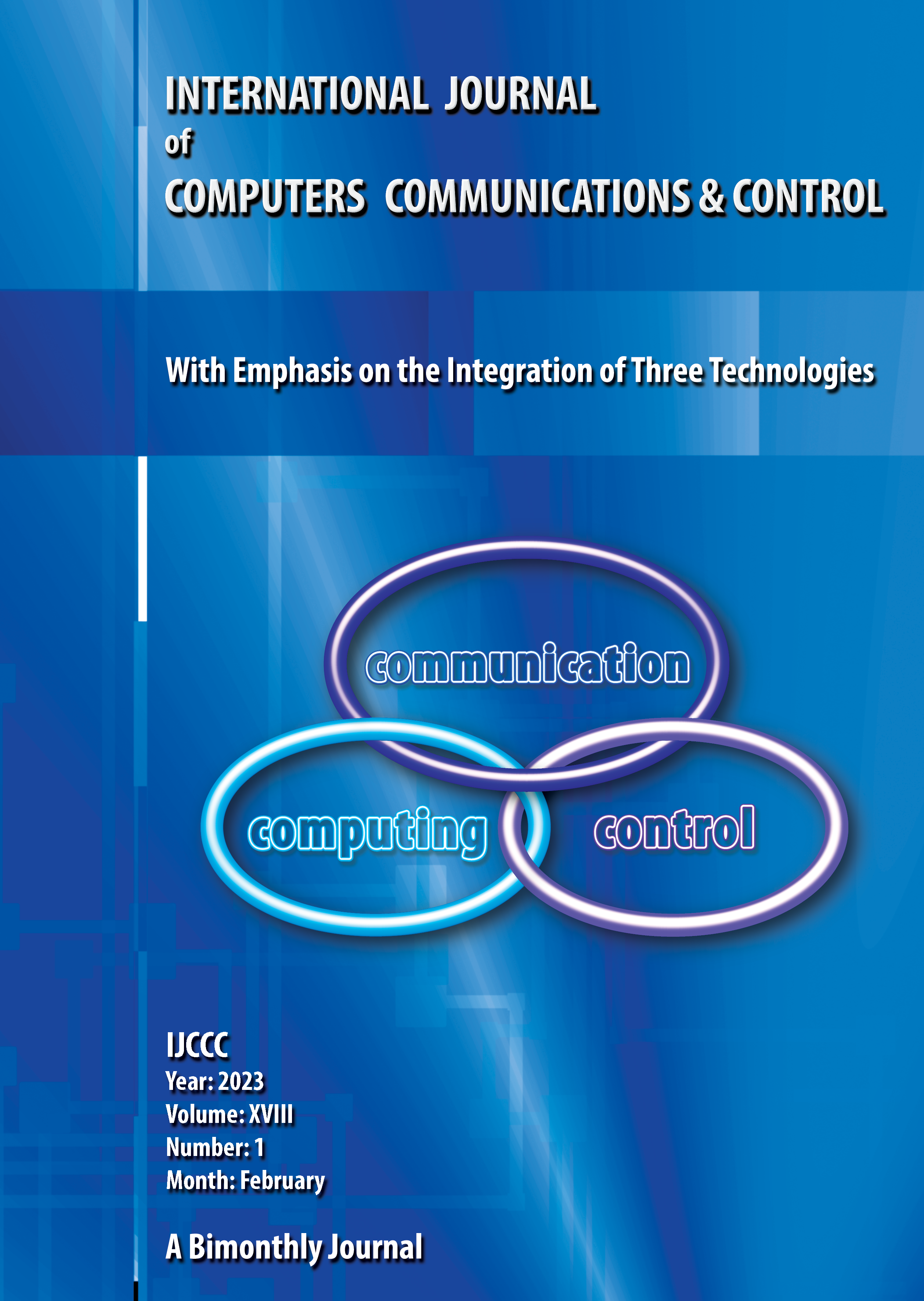Covid-19 Forecasting Using CNN Approach With A Halbinomial Distribution And A Linear Decreasing Inertia Weight-Based Cat Swarm Optimization
DOI:
https://doi.org/10.15837/ijccc.2023.1.4396Abstract
In recent times, the COVID-19 epidemic has spread to over 170 nations. Authorities all around the world are feeling the strain of COVID-19 since the total of infected people is rising as well as they does not familiar to handle the problem. The majority of current research effort is thus being directed on the analysis of COVID-19 data within the framework of the machines learning method. Researchers looked the COVID 19 data to make predictions about who would be treated, who would die, and who would get infected in the future. This might prompt governments worldwide to develop strategies for protecting the health of the public. Previous systems rely on Long Short- Term Memory (LSTM) networks for predicting new instances of COVID-19. The LSTM network findings suggest that the pandemic might be over by June of 2020. However, LSTM may have an over-fitting issue, and it may fall short of expectations in terms of true positive. For this issue in COVID-19 forecasting, we suggest using two methods such as Cat Swarm Optimization (CSO) for reducing the inertia weight linearly and then artificial intelligence based binomial distribution is used. In this proposed study, we take the COVID-19 predicting database as an contribution and normalise it using the min-max approach. The accuracy of classification is improved with the use of the first method to choose the optimal features. In this method, inertia weight is added to the CSO optimization algorithm convergence. Death and confirmed cases are predicted for a certain time period throughout India using Convolutional Neural Network with Partial Binomial Distribution based on carefully chosen characteristics. The experimental findings validate that the suggested scheme performs better than the baseline system in terms of f-measure, recall, precision, and accuracy.
References
Elsheikh, A.H., Saba, A.I., Elaziz, M.E., Lu, S., Shanmugan, S., Muthuramalingam, T., Kumar, R., Mosleh, A.O., Essa, F.A., & Shehabeldeen, T.A. (2020). Deep learning-based forecasting model for COVID- 19 outbreak in Saudi Arabia. Process Safety and Environmental Protection, 149, 223 - 233.
https://doi.org/10.1016/j.psep.2020.10.048
Chintalapudi, N., Battineni, G., & Amenta, F. (2020). COVID-19 virus outbreak forecasting of registered and recovered cases after sixty day lockdown in Italy: A data driven model approach. Journal of Microbiology, Immunology, and Infection, 53, 396
https://doi.org/10.1016/j.jmii.2020.04.004
Lukman, A.F., Rauf, R.I., Abiodun, O.E., Oludoun, O., Ayinde, K., & Ogundokun, R.O. (2020). COVID- 19 prevalence estimation: Four most affected African countries. Infectious Disease Modelling, 5, 827 - 838.
https://doi.org/10.1016/j.idm.2020.10.002
Yan, C.H., Faraji, F., Prajapati, D.P., Boone, C.E., & Deconde, A.S. (2020). Association of chemosensory dysfunction and COVID-19 in patients presenting with influenza-like symptoms. International Forum of Allergy & Rhinology, 10, 806 - 813.
https://doi.org/10.1002/alr.22579
Almaghaslah, D., Kandasamy, G., Almanasef, M., Vasudevan, R., & Chandramohan, S. (2020). Review on the coronavirus disease (COVID-19) pandemic: Its outbreak and current status. International Journal of Clinical Practice, 74.
https://doi.org/10.1111/ijcp.13637
Khajanchi, S., & Sarkar, K. (2020). Forecasting the daily and cumulative number of cases for the COVID-19 pandemic in India. Chaos, 30.
https://doi.org/10.1063/5.0016240
He, S., Tang, S., & Rong, L. (2020). A discrete stochastic model of the COVID-19 outbreak: Forecast and control. Mathematical biosciences and engineering : MBE, 17 4, 2792-2804 .
https://doi.org/10.3934/mbe.2020153
Kirbas, I., Sözen, A., Tuncer, A.D., & Kazanc-oglu, F.S. (2020). Comparative analysis and forecasting of COVID-19 cases in various European countries with ARIMA, NARNN and LSTM approaches. Chaos, Solitons, and Fractals, 138, 110015 - 110015.
https://doi.org/10.1016/j.chaos.2020.110015
D. N. V. S. L. S. Indira, Rajendra Kumar Ganiya, P. Ashok Babu, A. Jasmine Xavier, L. Kavisankar, S. Hemalatha, V. Senthilkumar, T. Kavitha, A. Rajaram, Karthik Annam, Alazar Yeshitla, "Improved Artificial Neural Network with State Order Dataset Estimation for Brain Cancer Cell Diagnosis", BioMed Research International, vol. 2022, Article ID 7799812, 10 pages, 2022. https://doi.org/10.1155/2022/7799812.
https://doi.org/10.1155/2022/7799812
Hu, Z., Ge, Q., Li, S., Jin, L., & Xiong, M. (2020). Evaluating the effect of public health intervention on the global-wide spread trajectory of Covid-19. medRxiv.
https://doi.org/10.1101/2020.03.11.20033639
Al-qaness, M.A., Ewees, A.A., Fan, H., & Abd El Aziz, M.A. (2020). Optimization Method for Forecasting Confirmed Cases of COVID-19 in China. Journal of Clinical Medicine, 9.
https://doi.org/10.3390/jcm9030674
Karthik, A., MazherIqbal, J.L. Efficient Speech Enhancement Using Recurrent Convolution Encoder and Decoder. Wireless Pers Commun 119, 1959-1973 (2021). https://doi.org/10.1007/s11277-021-08313-6.
https://doi.org/10.1007/s11277-021-08313-6
Castillo, O., & Melin, P. (2020). Forecasting of COVID-19 time series for countries in the world based on a hybrid approach combining the fractal dimension and fuzzy logic. Chaos, Solitons, and Fractals, 140, 110242 - 110242.
https://doi.org/10.1016/j.chaos.2020.110242
Hu, Z., Ge, Q., Li, S., Jin, L., & Xiong, M. (2020). Artificial Intelligence Forecasting of Covid-19 in China. International Journal of Educational Excellence.
https://doi.org/10.18562/IJEE.054
Elsheikh, A.H., Saba, A.I., Elaziz, M.E., Lu, S., Shanmugan, S., Muthuramalingam, T., Kumar, R., Mosleh, A.O., Essa, F.A., & Shehabeldeen, T.A. (2020). Deep learning-based forecasting model for COVID-19 outbreak in Saudi Arabia. Process Safety and Environmental Protection, 149, 223 - 233.
Additional Files
Published
Issue
Section
License
Copyright (c) 2023 Karthikeyan Madhu, Rajesh Khanna Murugesan, Jayalakshmi Sambandam, Lakshmanan Malliga

This work is licensed under a Creative Commons Attribution-NonCommercial 4.0 International License.
ONLINE OPEN ACCES: Acces to full text of each article and each issue are allowed for free in respect of Attribution-NonCommercial 4.0 International (CC BY-NC 4.0.
You are free to:
-Share: copy and redistribute the material in any medium or format;
-Adapt: remix, transform, and build upon the material.
The licensor cannot revoke these freedoms as long as you follow the license terms.
DISCLAIMER: The author(s) of each article appearing in International Journal of Computers Communications & Control is/are solely responsible for the content thereof; the publication of an article shall not constitute or be deemed to constitute any representation by the Editors or Agora University Press that the data presented therein are original, correct or sufficient to support the conclusions reached or that the experiment design or methodology is adequate.








